The U8000F is a very basic television that may find its buyers among those looking for the cheapest Samsung 4K with Smart TV. And that is exactly its purpose. Thanks to the Tizen system, this model offers quite a bit in terms of smart features – the number of applications and possibilities may catch the attention of those who want a reasonably smart device at the lowest price possible. When it comes to picture quality – it's average, which isn't surprising in this class. Nonetheless, there are a few upsides: quite decent viewing angles will work well for traditional TV viewing from different parts of the room, and the basic features for gamers (like VRR and ALLM) may be enough for typical "Sunday" gamers. The PC mode also deserves a mention – the television handles font display very well, so it can also serve as a cheap monitor. Of course, this is not a model that can be recommended to everyone "sight unseen." But if someone is looking for a cheap Samsung with 4K resolution and a solid Smart system, then the U8000F is just that kind of device.
- Matching (Score)
- Our verdict
- TV appearance
- Where to buy
- Contrast and black detail
- HDR effect quality
- Factory color reproduction
- Color reproduction after calibration
- Smoothness of tonal transitions
- Image scaling and smoothness of tonal transitions
- Blur and motion smoothness
- Console compatibility and gaming features
- Input lag
- Compatibility with PC
- Viewing angles
- TV efficiency during daytime
- Details about the matrix
- TV features
- Apps
- Playing files from USB
- Sound
Samsung U8000F (IPS) vs XIAOMI A PRO 2026
Direct compare
U8000F / U8092F
Available screen sizes: 55”

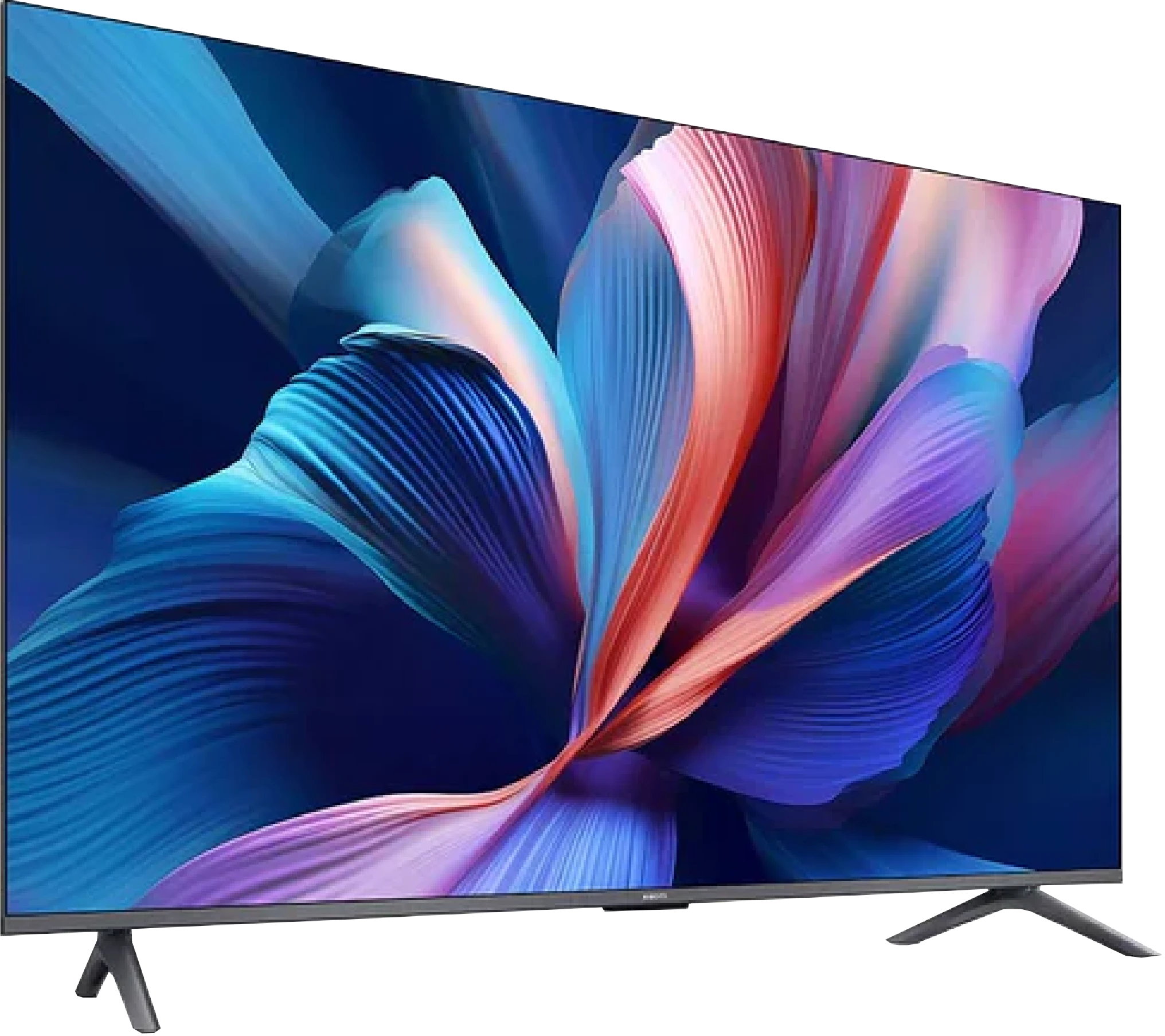
Panel type: LCD IPS
Resolution: 3840x2160
System: Tizen
Model year: 2025
Complete the survey to find out the result

Panel type: LCD VA
Resolution: 3840x2160
System: Google TV
Model year: 2025
Complete the survey to find out the result

Overall rating
5.4
5.6
Movies and series in UHD quality
4.9
6.0
Classic TV, YouTube
4.8
5.7
Sports broadcasts (TV and apps)
5.8
4.7
Gaming on console
6.3
6.2
TV as a computer monitor
6.0
2.0
Watching in bright light
3.4
4.9
Utility functions
5.3
6.1
Apps
8.7
9.6
Sound quality
5.7
5.0
Complete the survey to find out what fits your preferences
Advantages
Advanced Smart system: Tizen
Good viewing angles (IPS Matrix)
Great for working with text - excellently displays fonts
Low input lag
Basic features for gamers - VRR and ALLM
VA panel with good native contrast and decent blacks
Supports Game Boost mode at 120 Hz in 1080p and 1440p
Low input lag in 120 Hz mode
Google TV – vast selection of apps and services
Wide colour gamut coverage (around 94% DCI-P3)
Good colours after calibration in SDR mode
Supports popular audio formats (Dolby Atmos, DTS:X)
Large, easy-to-read remote with numeric keypad – convenient for seniors
Disadvantages
Low brightness
Very poor black level and contrast (IPS panel)
Inferior appearance compared to its predecessor
Infrared remote control
Low brightness
Lack of real support for HDR10+ and other more advanced HDR formats (e.g., Dolby Vision)
Significant limitations when working with PC – no chroma 4:4:4, heavy dithering, poor font readability
Poor viewing angles (typical for VA)
Clunky build, legs mounted in plastic with screws
Weird system issues – stuttering, errors with Miracast and sound switching
Upscaling and digital image processing is virtually non-existent
Very weak sound, practically no bass (we felt it performed worse than the "2025" model)
Our verdict
Xiaomi A Pro 2026 is a television that, at first glance, doesn’t reveal significant changes compared to its predecessor. Someone might even think it’s just a copy of last year's model with a different sticker. And there’s some truth to that, as the main novelty, or rather the only noticeable difference, is the 120 Hz mode at lower resolutions. It must be said that Xiaomi has done well here; this addition really makes a difference – it’s not a solution for professional gamers, but a nod towards those looking for a smoother image during casual gaming. This is where the A Pro 2026 can stand out – with a simple yet clever idea that sets it apart in the “super budget” segment. Unfortunately, when we start looking at the television more broadly, the enthusiasm quickly wanes. Even though the year has changed on the calendar, most of the issues known from the A Pro 2025 are still with us – the system can still experience strange stutters, and the occasional errors can be quite frustrating. On top of that, there's a lack of any serious digital image processing tools, which worked quite decently last year. As a result, there are many limitations in the design that the competition in a similar price range is already trying to cover up in some way. When it comes to image quality, we won't sugarcoat it either. Brightness at the level of 200–300 nits doesn’t stand a chance against more demanding content. Sure, with simpler streaming content, you can watch something, but with high-budget productions, it’s immediately clear why the television costs what it does. The impression that we are viewing a flat image stripped of details accompanies us pretty much every time. And this brings us to the crux of the matter. The Xiaomi A Pro 2026 is a television for those who really don’t demand much. As a daily screen for series, news, or YouTube, it performs decently, especially thanks to its operating system, which is GoogleTV. Also, if someone is looking for budget equipment and would additionally like a taste of smoother gameplay in games thanks to the 120 Hz mode, they might even be satisfied. However, anyone expecting at least average image quality, a stable system, and proper functionality will soon notice that there are other budget models on the market that simply perform better.
TV appearance





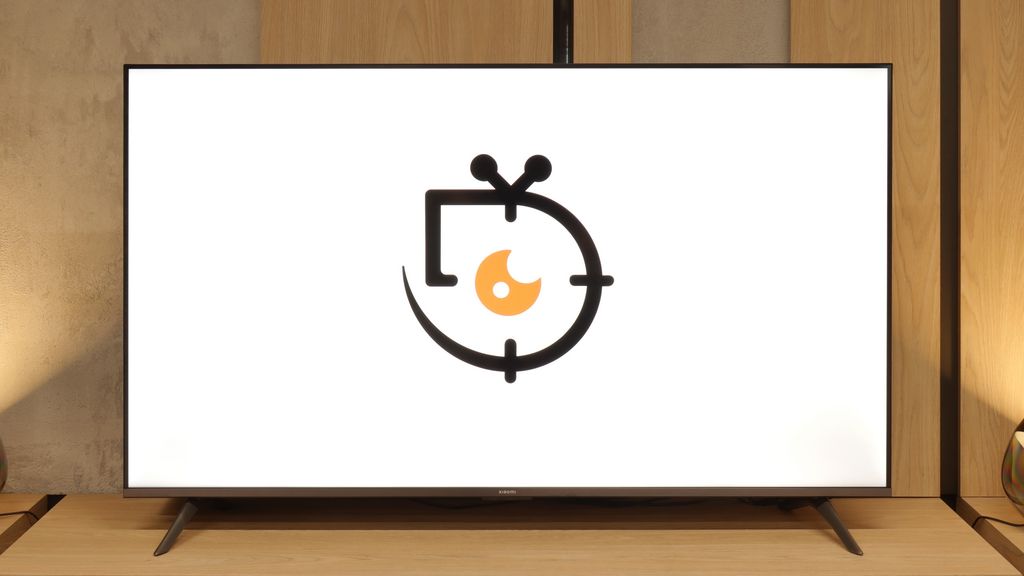
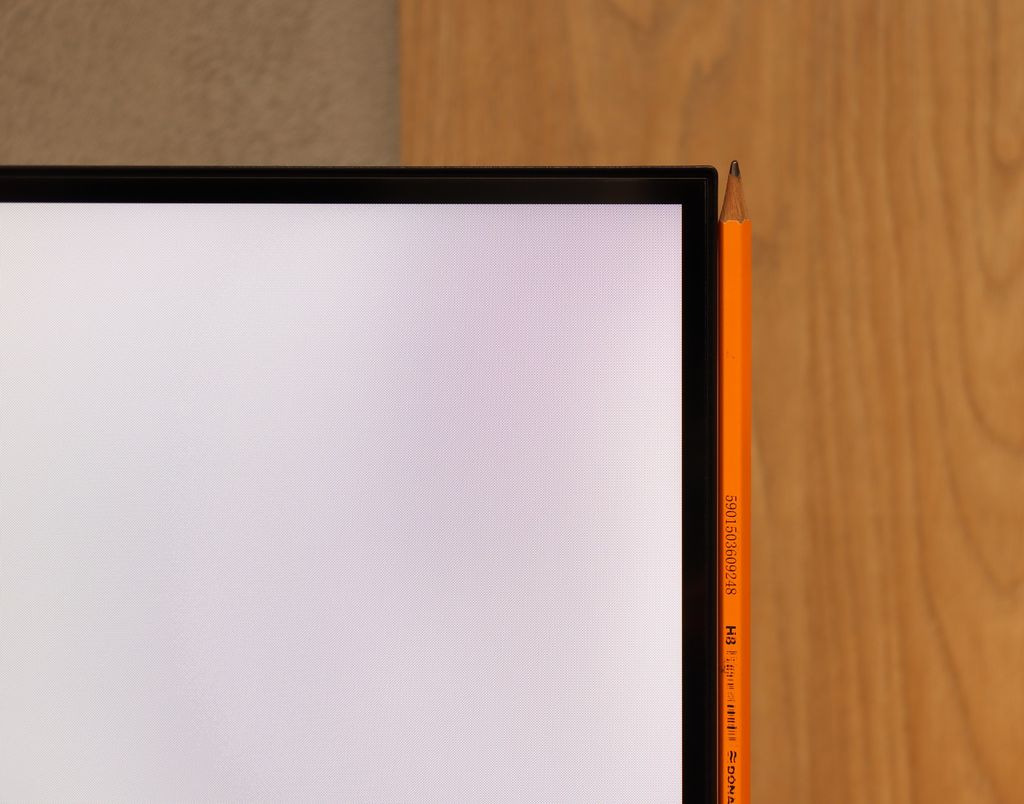
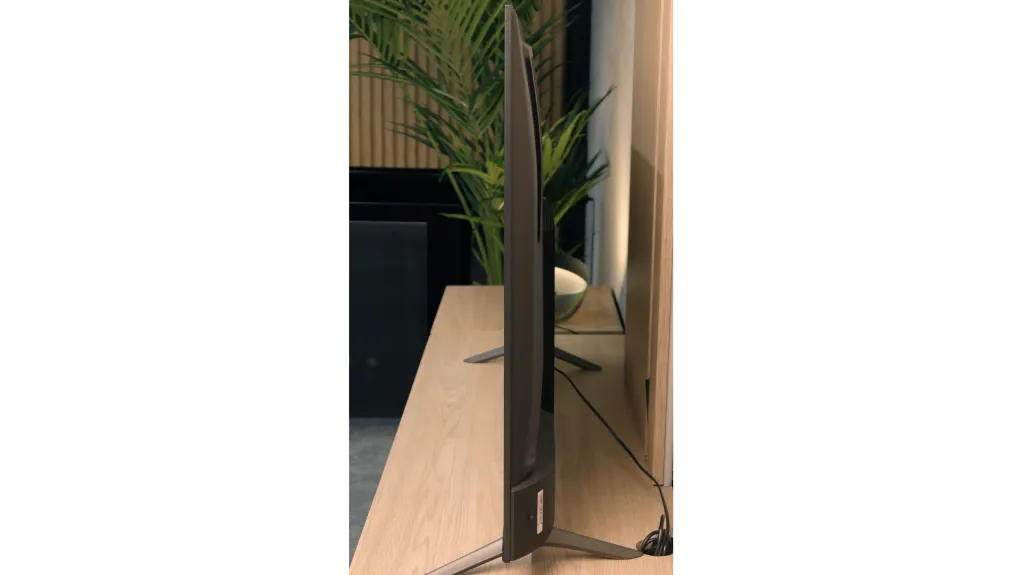
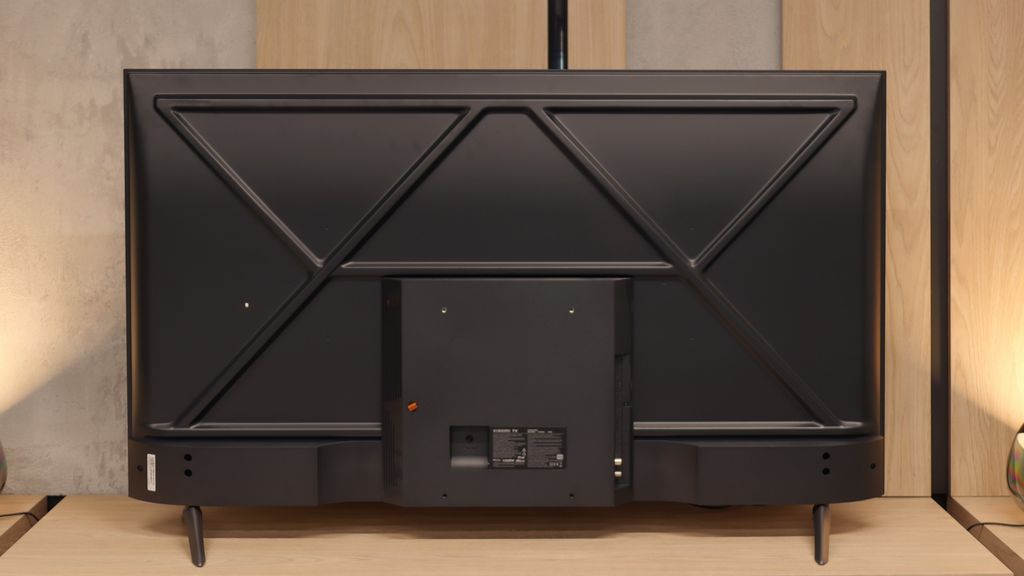
Contrast and black detail
1.1/10
6.1/10
Local dimming function: No
Local dimming function: No
Contrast:

Result
900:1

Result
800:1

Result
700:1

Result
700:1

Result
650:1

Result
5,000:1

Result
6,550:1

Result
7,300:1

Result
6,600:1

Result
4,900:1
Halo effect and black detail visibility:


Samsung U8000F, or more precisely the U8092F model in the 55-inch version, is equipped with an IPS panel. Let’s be honest – this is not the best choice when it comes to properly displaying blacks and contrast. The results in this category are simply poor. The contrast is abysmal, and watching dark scenes with any kind of “cinematic” effect is nearly impossible. Additionally, the fact that the TV lacks local dimming doesn’t help, making it difficult to achieve better results. The only thing that deserves praise is the quite decent uniformity of the panel – but that’s more of a minor consolation. Overall, it’s not good. If you care about deep blacks and reasonable contrast, it’s definitely better to go for a variant with a VA panel, which performs significantly better in this particular series.
One of the biggest advantages of even a budget construction like the Xiaomi A Pro 2026 is the VA panel it uses. This is responsible for quite decent contrast, which in our measurements oscillated between 5000:1 and 7000:1. On the screen, this translates to a stable image with fairly deep blacks – something that's hard to find in competing models with IPS panels without local dimming. Xiaomi has also added a global dimming function for the entire panel. It sounds good, but… we advise turning it off straight away. Why? Because the screen behaves very strangely in darker scenes – sometimes it dims so much that you can hardly see anything, and other times it brightens so much that the already dark blue-black turns into a bright blue. At those moments, it felt as if the TV was simply damaged. Fortunately, without this function, the contrast looks really solid. It’s definitely not on the level of advanced TVs with local dimming, but in its price range, it will easily satisfy most users – especially if you’re not watching in a completely dark room and have at least some background light that effectively masks the imperfections of the "blue-black".
HDR effect quality
3/10
4.1/10
Luminance measurements in HDR:

Result
191 nit

Result
224 nit

Result
241 nit

Result
79 nit

Result
234 nit

Result
220 nit

Result
248 nit

Result
322 nit

Result
315 nit

Result
326 nit
Scene from the movie “Pan” (about 2800 nits)


Scene from the movie “Billy Lynn” (about 1100 nits)


Static HDR10


Dynamic: HDR10+
Dynamic: HDR10+


HDR luminance chart:
XIAOMI A PRO 2026
HDR luminance
Samsung U8000F (IPS)
HDR luminance
Better doesn't mean good – and that's exactly how you can sum up the capabilities of the U8092F when it comes to displaying bright movie scenes in HDR mode. The brightness of the panel is just under 250 nits, which is definitely too low to enjoy any light effects. An interesting situation was observed during measurements of the fourth scene from the movie Sicario 2 – the television clearly dimmed the entire screen in an attempt to achieve better black levels (which still remain weak). One could even suggest that the device employs some form of "global dimming," but unfortunately – the effects are still very poor. To make matters worse, the television does not support a wide colour gamut – the coverage of the DCI-P3 space is around 80%, so don’t count on truly vibrant colours. The HDR image here looks more like slightly brightened SDR, and that’s the approach we would suggest you stick to when it comes to this television.
If you're counting on the cinematic HDR experience in the new Xiaomi A Pro 2026, it's best to temper your expectations. This TV is simply too dim to fully realise the potential of contemporary films or series designed for the highest quality image. Our measurements showed brightness levels in the range of 200–300 nits, which are values that are more suited to SDR content than to ambitious HDR productions. In practice, this means that while most films look decent, they certainly won't evoke the 'wow' effect that other TVs do. Fortunately, not everything is lost – credit has to be given to the PFS LED filter used here, a solution similar to the quantum dot technology found in QLEDs. Thanks to this, the coverage of the DCI-P3 colour palette reaches about 94%, resulting in vibrant, saturated colours in the vast majority of materials.
Factory color reproduction
6.5/10
3.5/10


Factory Mode
After calibration


Factory Mode
After calibration
Samsung U8000F has been tested in the best possible built-in picture mode on the television, which is Filmmaker Mode. This mode should – at least in theory – provide a cinematic, reference image without unnecessary enhancements. For SDR content (mainly HD/SD), the television presented itself surprisingly well out of the box. White balance errors hovered around a value of 3, which is roughly on the edge of perceptibility. The only criticism could be directed at brightness management – the gamma chart showed a slight tendency to brighten or darken certain sections, but overall it performs quite well for this price segment.
Unfortunately, it looks much worse in HDR mode. Although the white balance was not terrible, the television had significant colour errors – particularly evident on the Color Checker chart, where almost every sample fell outside the target point. The image in HDR simply looks unnatural, and the colours can be shifted, muted, or too cool. This largely stems from the fact that U8000F does not support a wide colour gamut (DCI-P3). The television is physically unable to display correct colours in the HDR standard – and this is unfortunately felt in every more demanding material.
What we saw in Filmmaker mode really surprised us – and unfortunately not in a good way. The mode advertised as the Hollywood standard resembled more of a display in a shop window. The white balance was shifted towards blue, which led to massive colour errors and the effect of blown-out scenes in SDR content. It was a bit better, though far from perfect, in HDR materials. There were also problems there – colour saturation and the entire palette consistently drifted towards cooler tones, resulting in an image that had an artificial, cold tint rather than a cinematic character. In other words: even in Filmmaker mode, which should be the showcase of this television, we got an effect far from expectations.
Color reproduction after calibration
7.5/10
7/10




Even though the U8000F already offered a fairly good picture in SDR straight out of the box, we managed to tweak it a bit more. We were able to remove a slight purple tint and adjust the gamma to a more reasonable level. However, the television still tends to over-brighten the smallest and brightest parts of the image – the gamma chart shows a characteristic "dip" that is hard to fully straighten out.
Unfortunately, the situation looks worse in HDR. It's difficult to talk about any significant improvement here – the television simply isn't designed for HDR content. We tried to adjust the picture in the advanced settings, but despite our efforts, the colour errors remained quite noticeable – a delta E above 7 is already significantly visible deviations. It's a bit unfortunate, but that's the charm of a budget build. In SDR, the U8000F performs reasonably, whereas HDR is simply not its league.
Even though Xiaomi isn't a brand associated with top-tier televisions, it's fair to say that even in a budget model like the A Pro 2026, the manufacturer left plenty of calibration settings. After a few adjustments, the SDR picture took on a completely new look. The colours stopped veering into blue tones, the whites gained a sense of naturalness, and most errors dropped to a practically invisible level. As a result, SDR content looked very good, surprisingly so for this price range.
It was a slightly different story with HDR materials. Here, it was immediately noticeable what we had already mentioned – the overexposure of bright scenes and issues with balance control. Calibration helped only partially, as the limitations of the panel itself were at play. However, it must be emphasized that in the case of SDR, the television changed beyond recognition, and definitely for the better.
Smoothness of tonal transitions
9/10
9.3/10












Another important thing to pay attention to when assessing image quality is the smoothness of tonal transitions – that is, how the television handles blending colours and shades. And here the Samsung U8092F performs... almost perfectly. On the tested images, there are no noticeable banding transitions, no issues with colourful gradients, and the whole picture isn't artificially sharpened, which unfortunately happens with many televisions in this class. The image looks natural and very clear. We noticed minimal problems with the brightest scenes, but that's more of a nitpick that only a very trained eye would catch.
The television really handles colour blending well, and in most scenes it's hard to spot any imperfections. This is best showcased in the brighter parts of films, where tonal transitions look almost perfect, and the image is smooth and natural. Darker scenes are somewhat less impressive, where the characteristic banding can be seen. Fortunately, this isn't a flaw that stands out, and for most viewers, it will remain virtually unnoticeable.
Image scaling and smoothness of tonal transitions
5/10
3/10
Smooth transition function


Image without overscan on the SD signal


When it comes to how the Samsung U8000F handles lower quality materials, we must admit that Samsung has made progress compared to its predecessor from last year – the DU7192 model, which theoretically occupies the same place in the offering.
This year's model has been equipped with a function to improve the smoothness of tonal transitions, which has been implemented significantly better than last year. Yes, the TV still uses quite strong algorithms that can distort details or remove film grain, but even so – it can be confidently said that it operates effectively.
However, not everything has gone perfectly. The U8000F has noticeable issues with slight frame stuttering when watching very old content in very low resolution. If someone plans to play their old VHS tape, they must be aware that the picture may appear slightly "choppy".
Upscaling and digital image processing in the Xiaomi A Pro 2026 are not among the model's strong points. One might expect that since the television was not designed to achieve record brightness levels, the manufacturer would have opted for a more robust processor and a set of features that would "enhance" lower quality images. Unfortunately – we were also met with significant disappointment here. On the plus side, it has reasonably decent upscaling, which handles HD content and boosts it to 4K in an acceptable manner. However, that is where the list of advantages ends. The television does not offer any features to improve tonal transitions or smooth out digital imperfections, so in most cases, we receive a raw image, exactly as we deliver it from an external source. On a large screen, this lack of support makes lower quality content look simply bland. An additional problem is the phenomenon of overscan. When watching older material, it happens that part of the image is cut off, which only intensifies the impression that Xiaomi has quite a bit of catching up to do in this category.
Blur and motion smoothness
6/10
4.5/10

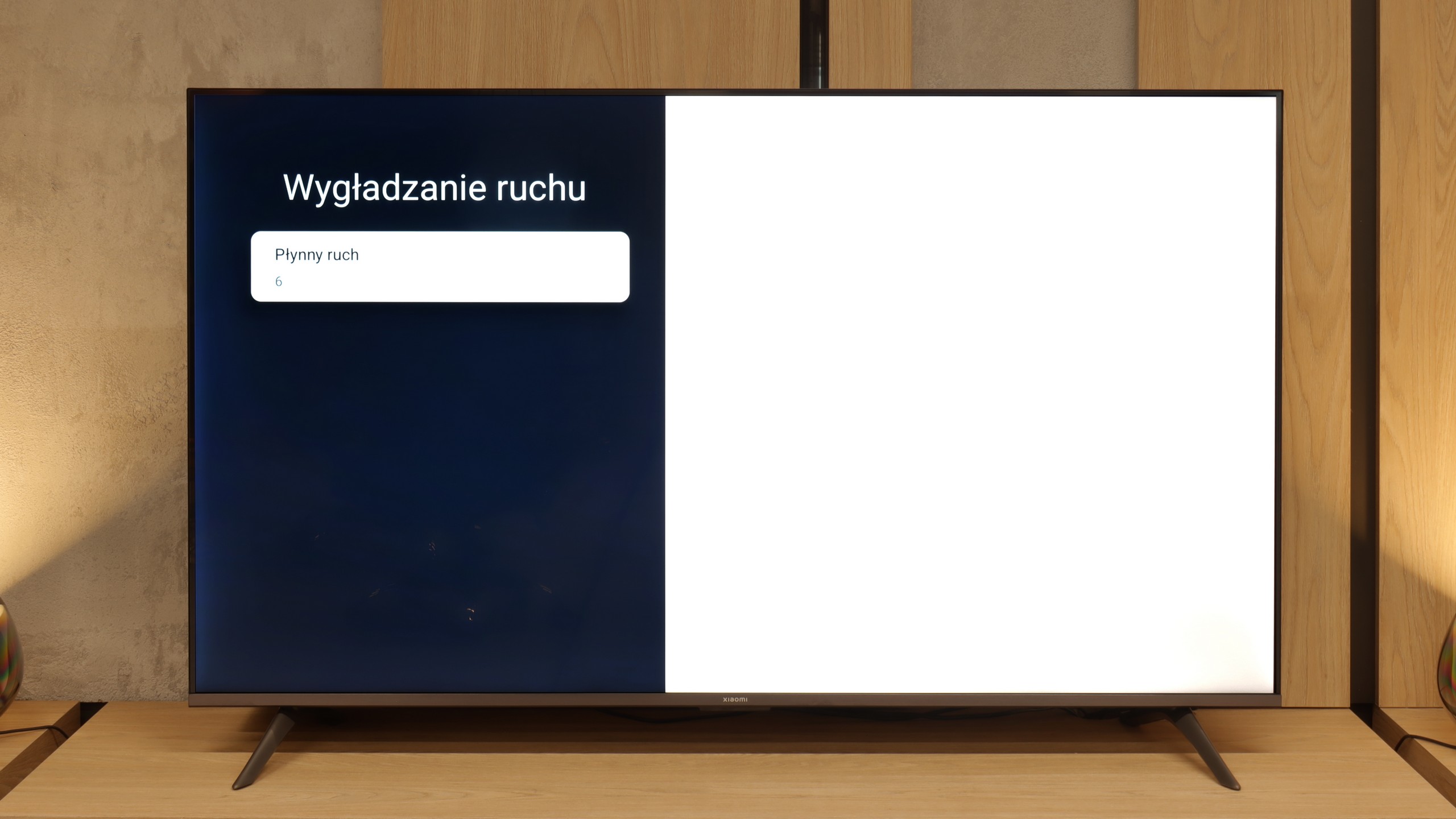
Blur (native resolution, maximum refresh rate):






Blur (BFI function enabled):
Image flickers in this mode



Smużenie ():
Smużenie (1440p@120Hz):



Samsung U8000F is equipped with a 60 Hz panel, so right from the start, it's clear that we shouldn't expect miracles. This is simply the standard in this class – sufficient for everyday viewing, but without any fireworks.
The television offers one motion smoothing slider – a feature called “Motion Blur Reduction”, which allows us to adjust the smoothness of the image in movies. Higher settings provide a more “theatrical” and smoothed effect, while lower ones maintain the original character of the film with a slight 24p effect. An interesting feature is “Clear Motion LED”, or BFI mode – which inserts black frames between the image frames to enhance motion clarity. However, in practice, the screen flickers significantly when it's activated, and it's better viewed as an experiment rather than something that truly enhances gaming comfort.
The motion fluidity in the Xiaomi A Pro 2026 is an interesting compromise that results from the hybrid matrix used here. At a native resolution of 4K, the maximum refresh rate is 60 Hz – sufficient for those who mainly watch movies and series. It is with them in mind that the manufacturer added a motion smoother, allowing users to adjust the image to their own preferences – one can opt for greater fluidity or leave it with more "cinematic" frames depending on the settings.
Console compatibility and gaming features
4/10
3.6/10
- ALLM
- VRR
- VRR range48 - 60Hz
- Dolby Vision Game Mode
- Correct implementation of HGIG
- 1080p@120Hz
- 1440p@120Hz
- 4K@120Hz
- Game bar

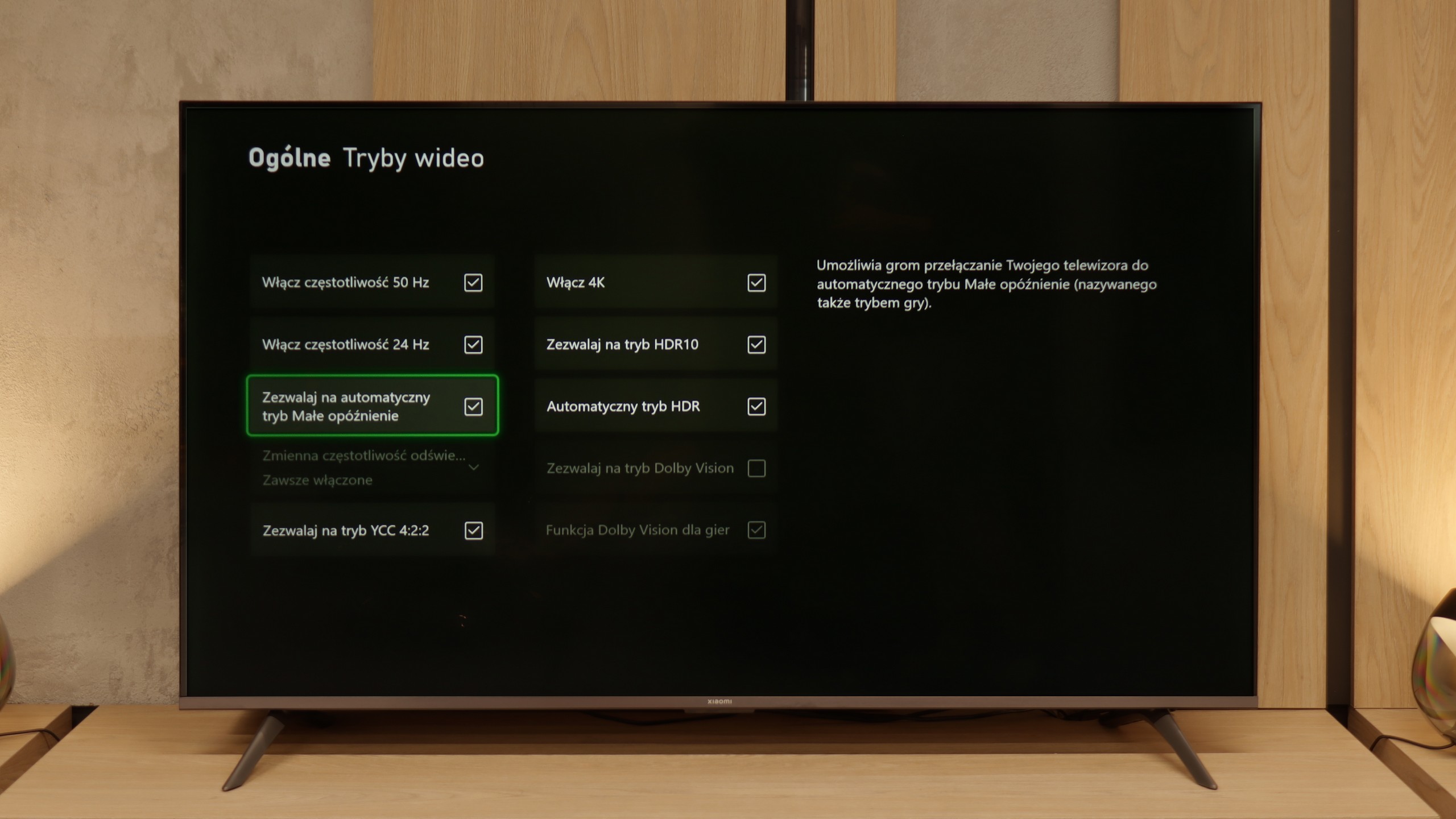

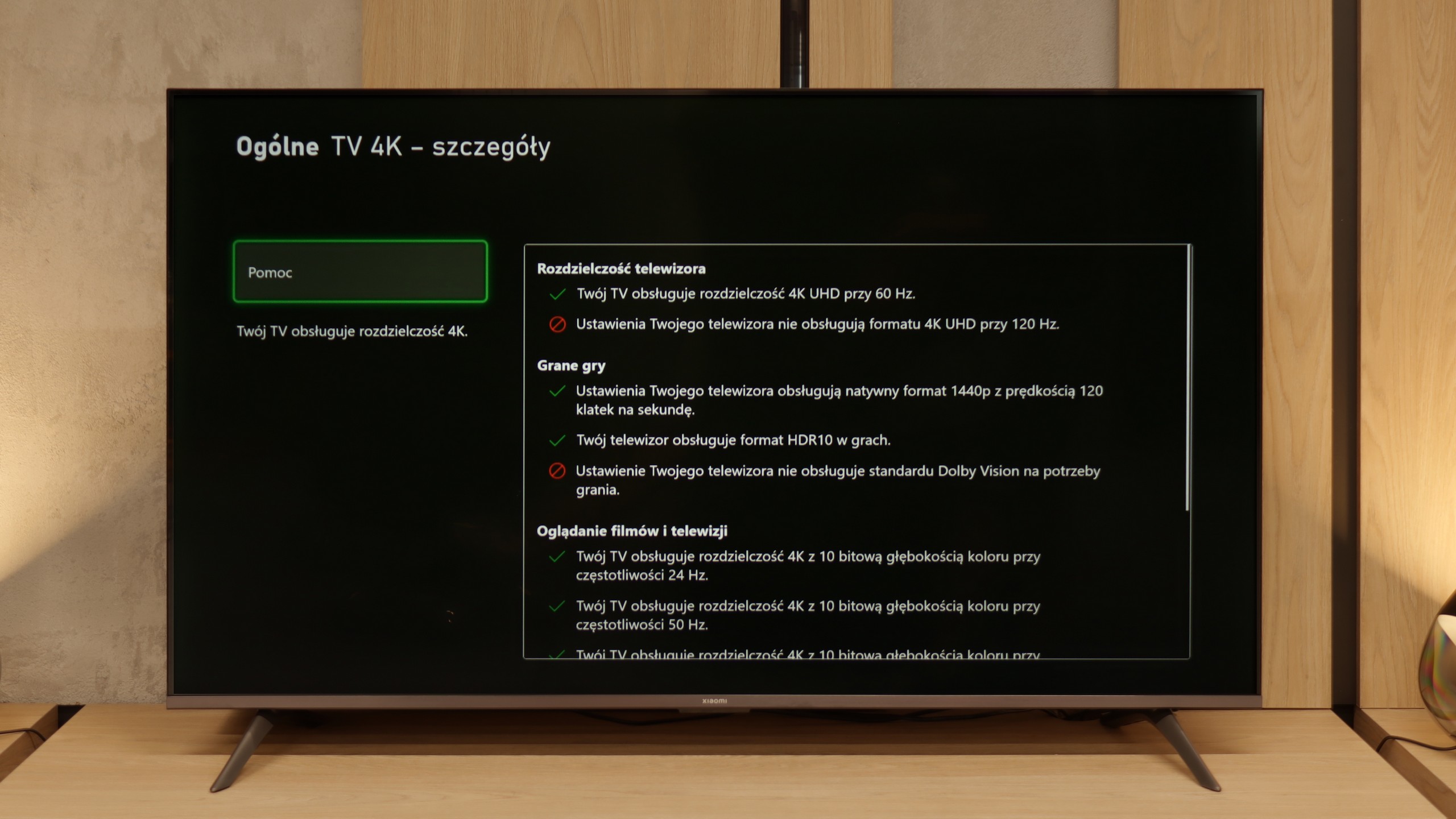

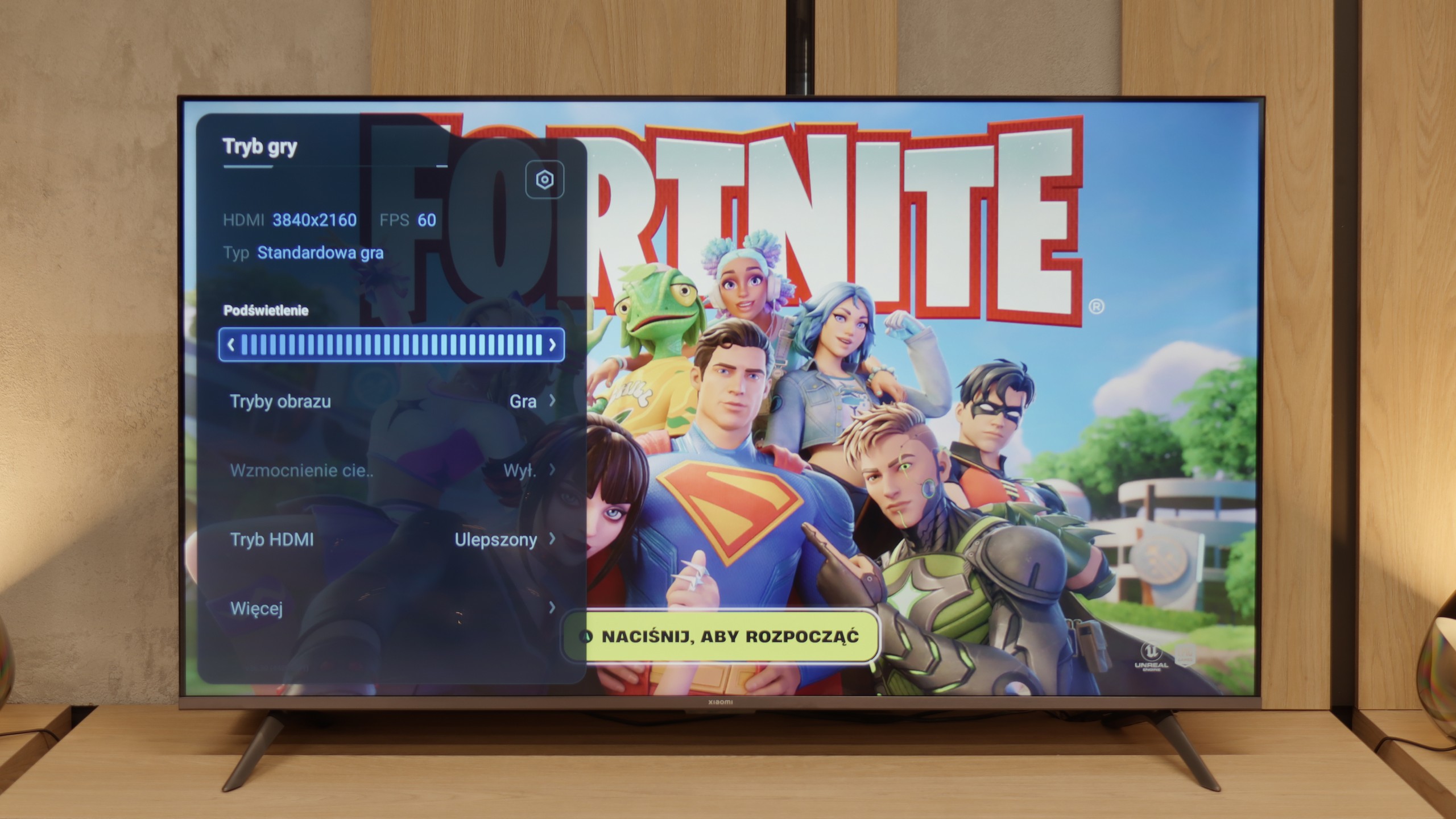

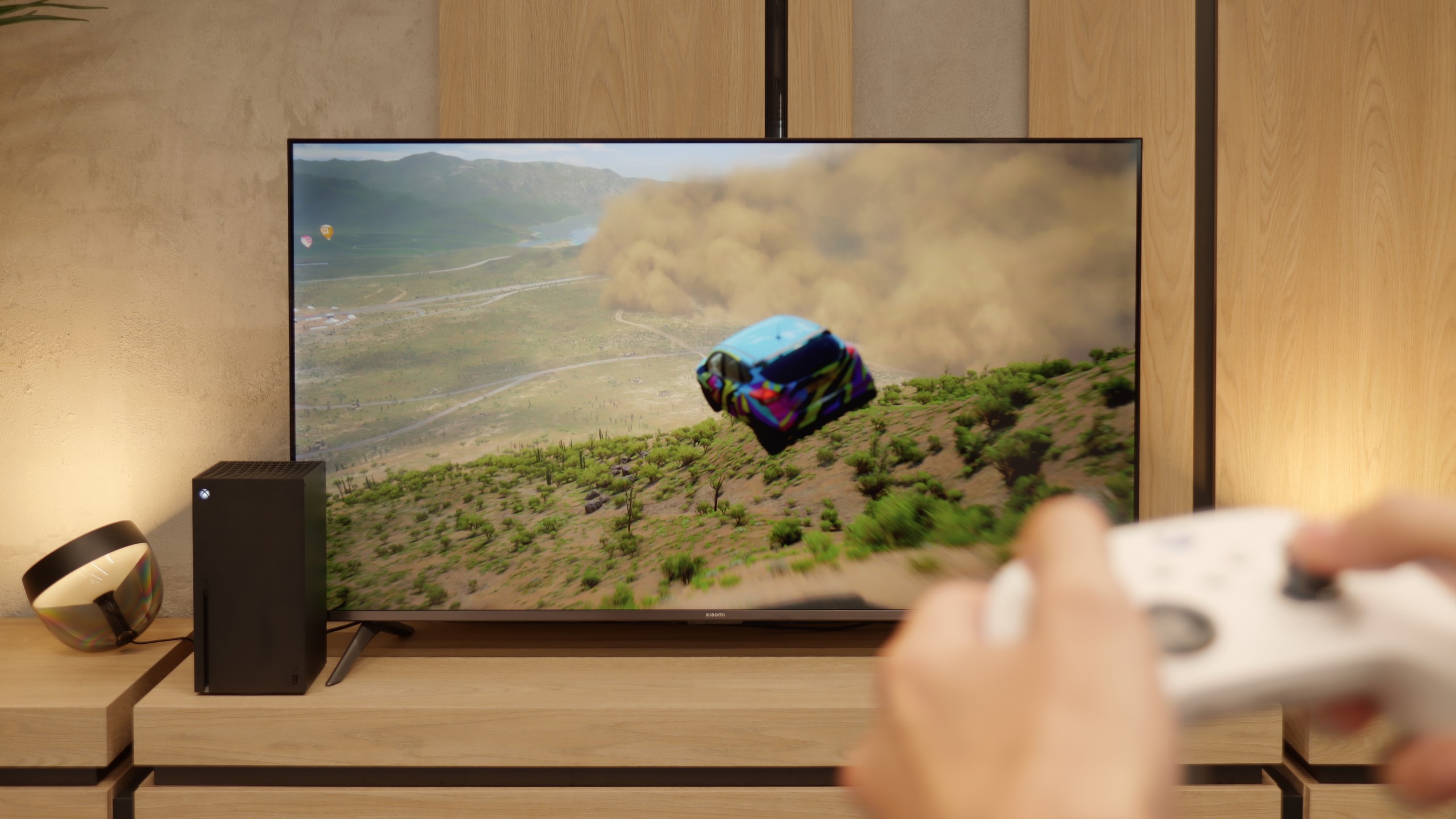
Samsung U8000F offers a basic set of features for gamers, which may still be sufficient for less demanding users. It has an automatic game mode – when a game is launched on the console, the TV automatically switches to low latency mode, which significantly improves response time. It also includes a VRR function, or variable refresh rate, which works within the range of 48 to 60 Hz. This means that both Xbox and PS5 won't produce the "tearing" effect – as long as we stay within this range.
And unfortunately, that's about it for the advantages. Additional features like Game Bar or higher refresh rates are reserved for higher models of Samsung’s 2025 line. In theory, the TV also supports the HGiG function, which should adjust the HDR image to the intentions of game developers. Unfortunately – although this function appears in brochures and store materials – its setup on the Xbox console turned out to be... impossible in practice.
No indeed – since Xiaomi has added the "Game Boost 120 Hz" feature here, one might expect that they'd follow up with a solid gaming package. Unfortunately, reality quickly dampens that enthusiasm. Aside from this mode (which, it must be said, is a great addition in a budget build), we only have a rather peculiar player panel. It's hard to call it a full-fledged "game bar" – it's more of a simple overlay on the TV's Menu with limited options. And that’s about it. There’s no ALLM, so the TV won’t switch to game mode automatically. There’s no VRR, so you can forget about smooth frame synchronisation. We also won’t find support for Dolby Vision in games or the HGiG format, which are increasingly becoming the standard on consoles. In short: apart from Game Boost 120 Hz, which indeed allows for a more enjoyable experience at 1080p or 1440p, Xiaomi A Pro 2026 offers nothing that particularly appeals to gamers.
Input lag
10/10
9.5/10
SDR
HDR
Dolby Vision
The Samsung U8092F performed phenomenally well in our input lag tests. Regardless of resolution or mode – the results were very low, which is quite impressive for this price segment. Therefore, it’s safe to say that gaming on this TV will not cause frustration due to significant delays between what we do on the controller and what we see on the screen. For most gamers, even the more demanding ones, this result should be more than satisfactory.
Input lag on the Xiaomi A Pro 2026 is quite decent and definitely isn't its weak point. The best results were achieved in 1080p@120 Hz and 1440p@120 Hz modes – there the TV drops below 10 ms, which can easily be called a phenomenal result and sufficient even for more demanding gamers. The situation changes with 60 Hz content – input lag then increases to around 25 ms. These might not be the best figures on the market, but for casual gaming or firing up the console in the evening, they will be fully acceptable. Especially since in most cases, it’s worth activating the 120 Hz mode, which is the most beneficial for gamers.
Compatibility with PC
6/10
2/10

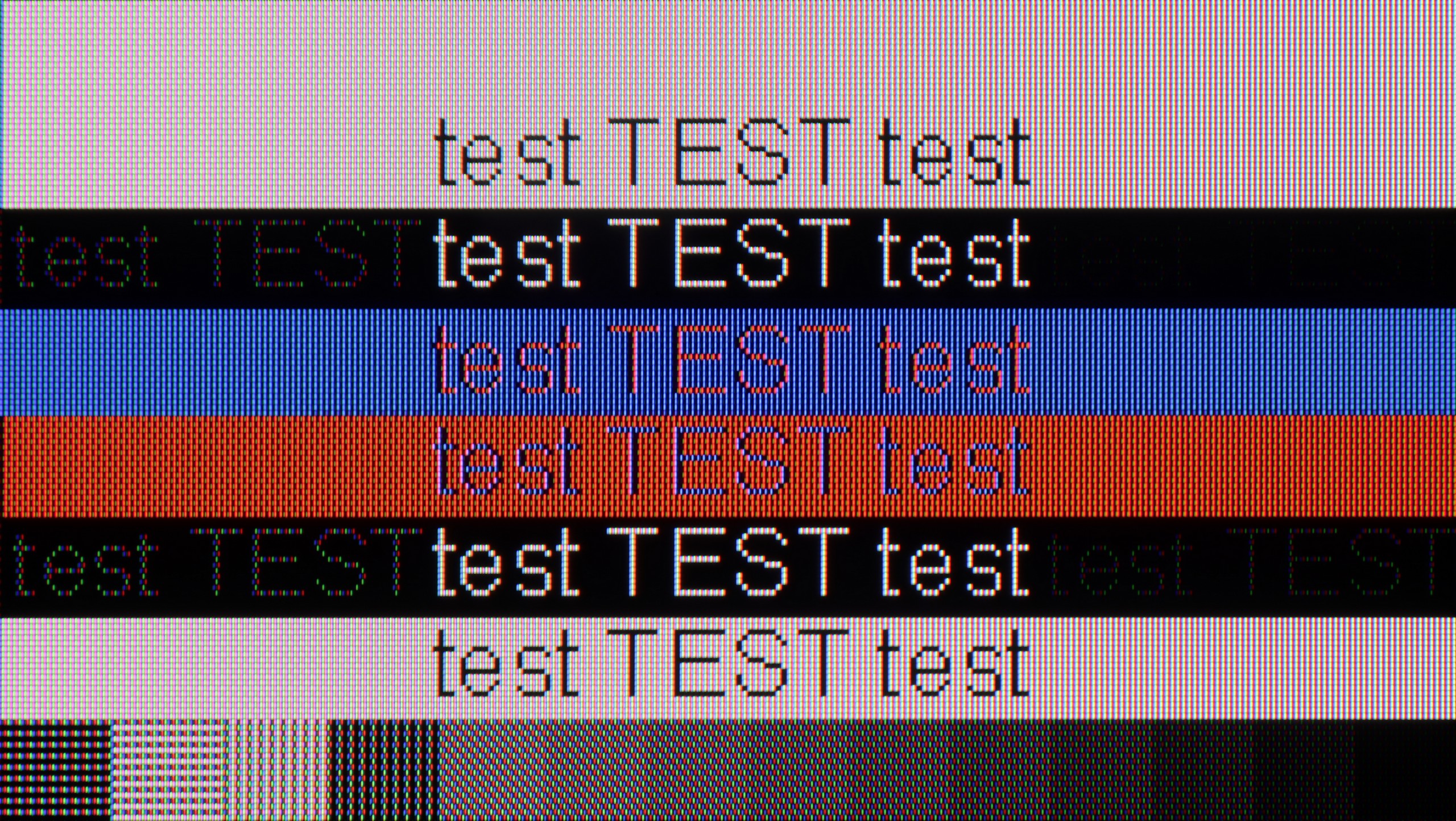
Working on the computer using this television is a real pleasure. The Samsung U8092F supports chroma 4:4:4, and thanks to the arrangement of the sub-pixels in the IPS panel, the readability of fonts – regardless of colour or size – is very, very good. The television is also suitable for occasional gaming on PC, mainly due to the low input lag. However, one must keep in mind that the G-Sync feature does not work on this model, which is strange because VRR worked without any issues when it came to the console.
Xiaomi A Pro 2026 as a computer monitor? There's no beating around the bush – it’s very poor. While you can still utilise the 120 Hz mode in lower resolutions for gaming, the TV is completely unsuitable for everyday work. It lacks full support for chroma 4:4:4, so fonts appear blurred, and sometimes even rainbow-like. Additionally, there's strong dithering, which makes the image look uneven – some pixels shine brighter while others dimmer, and vertical lines can even break apart. In practice, this means that text (especially coloured and on dark backgrounds) becomes difficult to read. Light text manages to hold up somewhat, but it’s hard to talk about any real comfort. In this category, we give the Xiaomi A Pro 2026 a score of 2/10 (+1 for the additional high refresh rate mode), and there’s really no sense in elaborating on this further.
Viewing angles
7/10
3/10
The viewing angles on the Samsung U8092F are very good – as is typical for an IPS panel. The image doesn’t lose much in terms of brightness or colour saturation, even with a greater deviation from the axis. Of course, it’s not on the level of organic screens – but it’s entirely sufficient for comfortably watching the image at an angle, for example, from the side of the couch.
The Xiaomi A Pro 2026 features a VA panel, which immediately suggests that viewing angles are not its strong suit. When looking at the screen from the side, you will quickly notice a loss of quality – colours noticeably fade, and the whole image appears washed out. The drop in brightness may not be as drastic as in some constructions based on similar technology, but that doesn’t change the fact that it’s clearly a weak point of this model. If we plan to use it as a large, cheap screen for the lounge, one must take this limitation into account.
TV efficiency during daytime
3.4/10
4.9/10

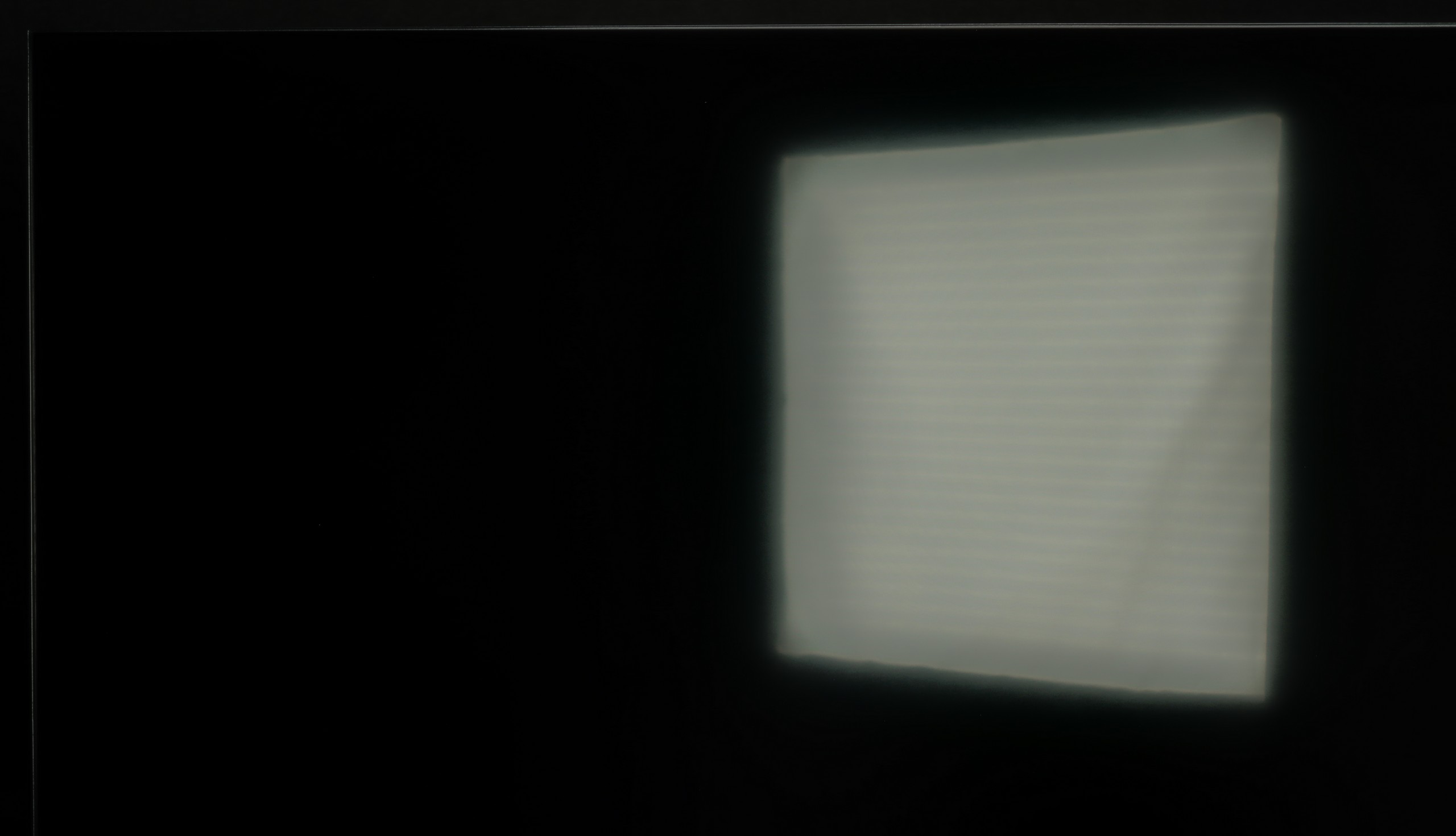


Matrix brightness
Average luminance SDR
XIAOMI A PRO 2026: 334 cd/m2
Samsung U8000F (IPS): 218 cd/m2
Thanks to the satin coating of the Samsung U8092F display, it handles reflections quite well. The screen doesn’t act like a mirror, and the colours – for a device of this class – remain fairly saturated, even in somewhat brighter conditions. Unfortunately, the coating alone can’t work miracles. The TV is just too dark to effectively shine through very challenging lighting conditions. If we place it opposite a light source (e.g. a large window or a strong lamp) – unfortunately, we need to accept that not everything will be clearly visible on it.
The Xiaomi A Pro 2026 performs quite well during the day. The display has a satin finish that helps reduce reflections, so colours don’t lose their vibrancy, even when the room is bright. Just bear in mind that it’s not an extremely bright screen – the average brightness is around 350 nits. In an ordinary, moderately sunny living room, it’s sufficient, but if you have large windows that let in a lot of sunlight, it might simply be tough without blinds or curtains.
Details about the matrix
Subpixel Structure:

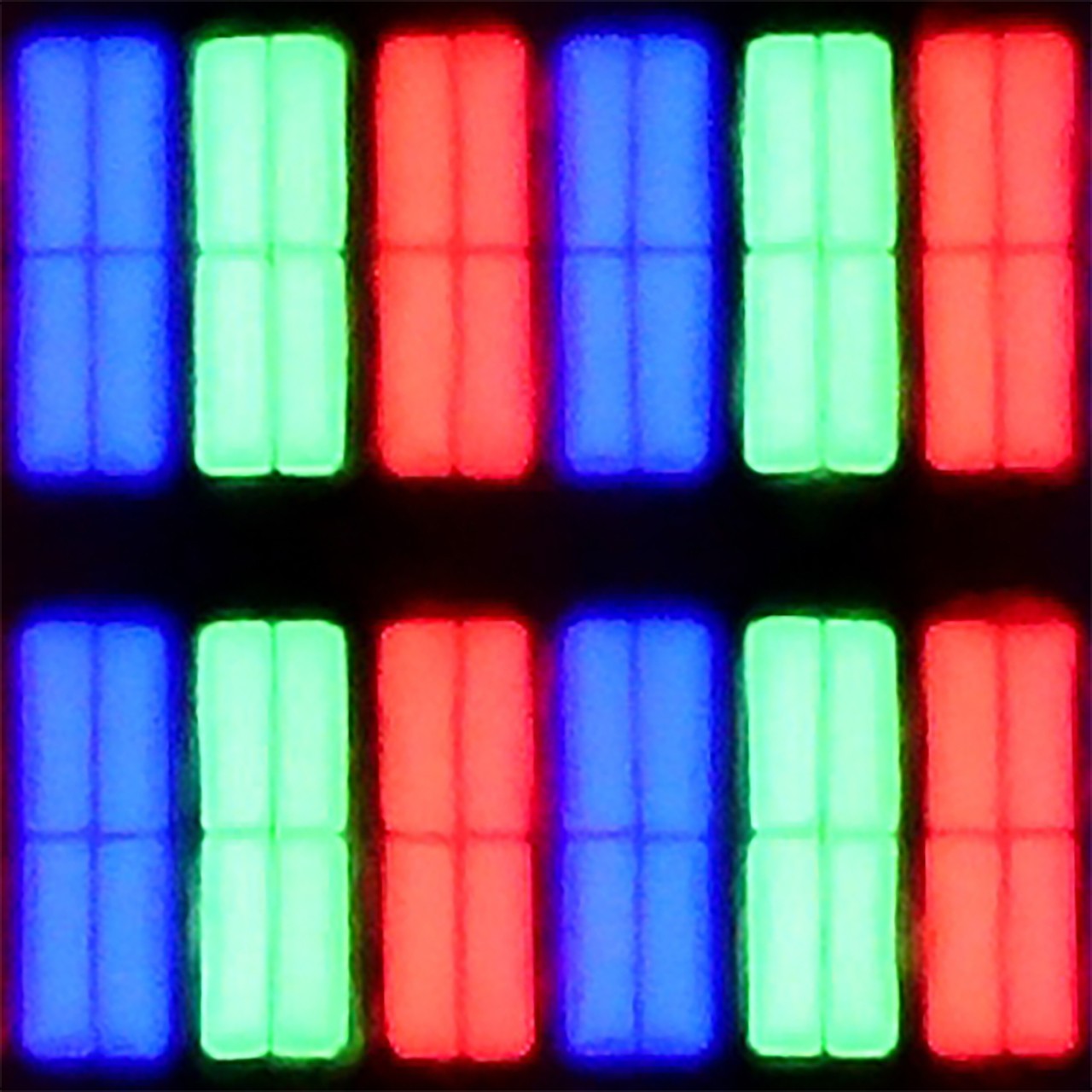
Panel uniformity and thermal imaging:


Samsung U8000F (IPS)
XIAOMI A PRO 2026
TV features
5.3/10
6.1/10
- HDMI inputs3 x HDMI 2.0, 0 x HDMI 2.13 x HDMI 2.0, 0 x HDMI 2.1
- Other inputsRCA (Chinch)
- OutputseARC (HDMI), ARC (HDMI)Toslink (Optical audio), eARC (HDMI), ARC (HDMI), Mini-Jack (Headphones)
- Network InterfacesWi-Fi 2.4GHz, Wi-Fi 5GHz, Ethernet (LAN) 100MbpsWi-Fi 2.4GHz, Wi-Fi 5GHz, Ethernet (LAN) 100Mbps
- TV receptionDVB-T, DVB-T2, DVB-S, DVB-S2, DVB-CDVB-T, DVB-T2, DVB-S, DVB-S2, DVB-C
Classic features:
- Recording to USB (terrestrial TV)
- Recording programming
- Picture in Picture (PiP)
- RF remote control (no need to aim at the screen)
- Backlit remote control
- Teletext
- Audio only mode
- Bluetooth headphones support
- Simultaneous Bluetooth headphones & TV audio
Smart features:
- AirPlay
- Screen mirroring (Windows Miracast)
- Voice search
- Voice search in native language
- Ability to connect a keyboard and mouse




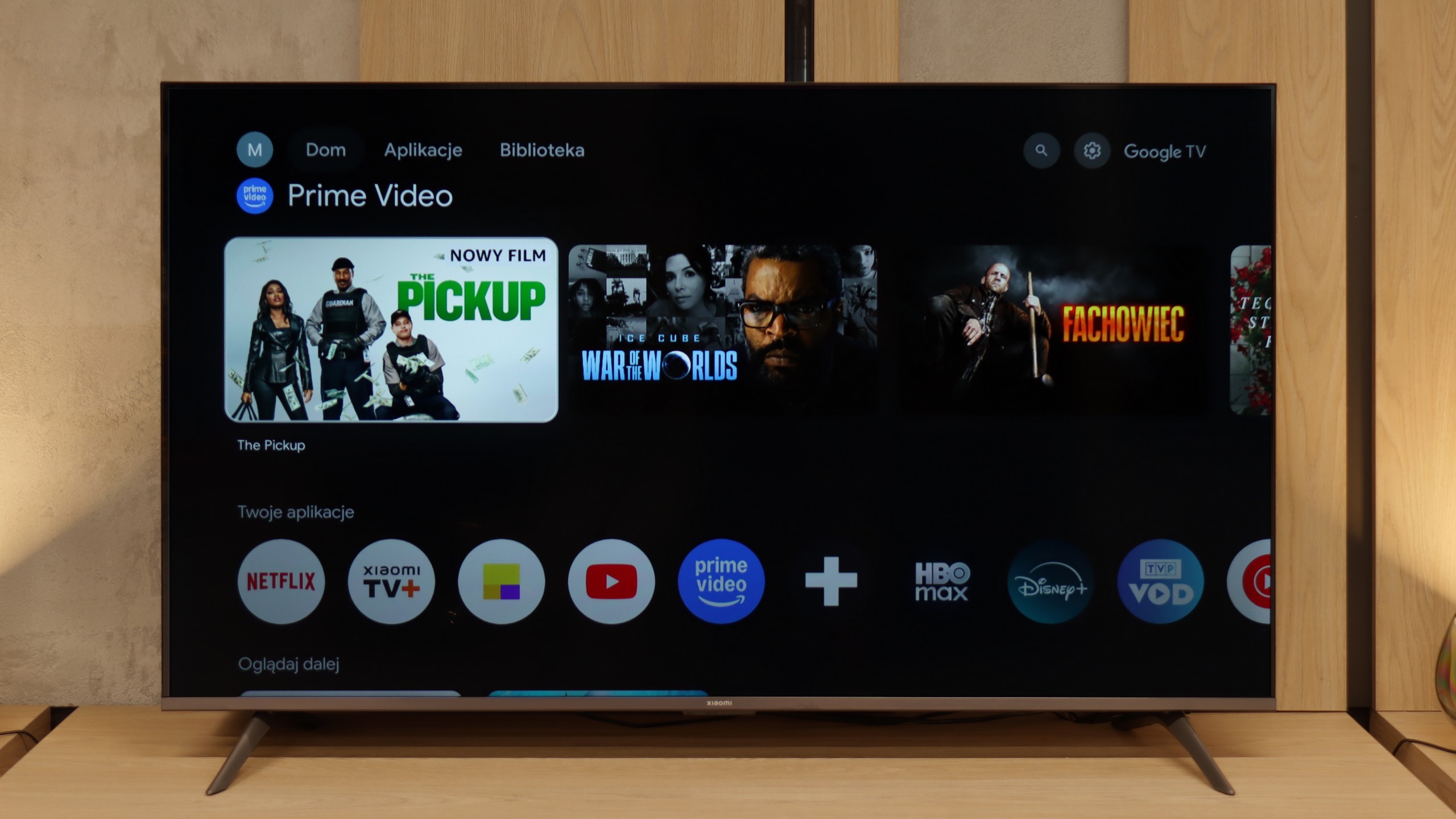
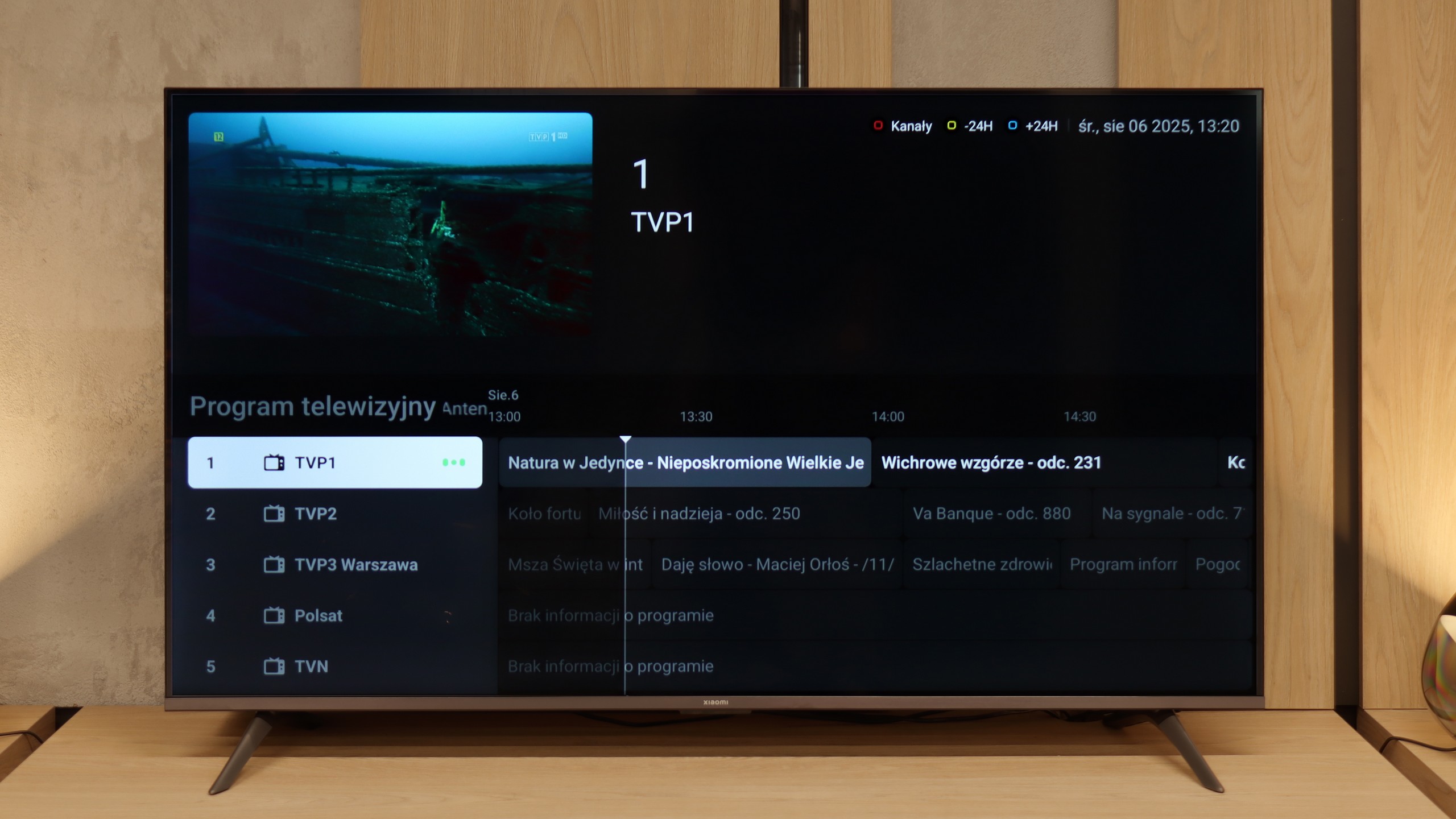
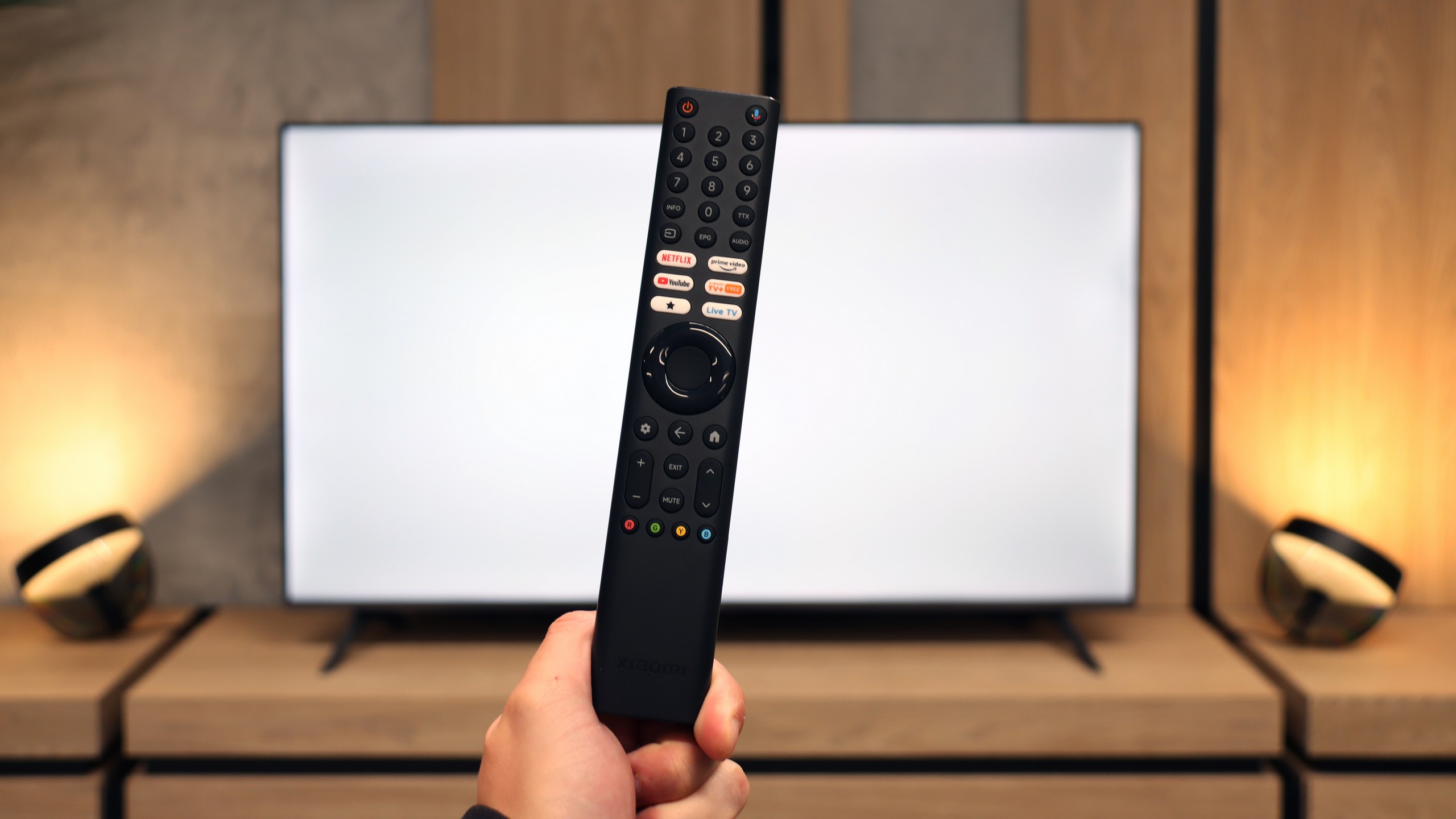
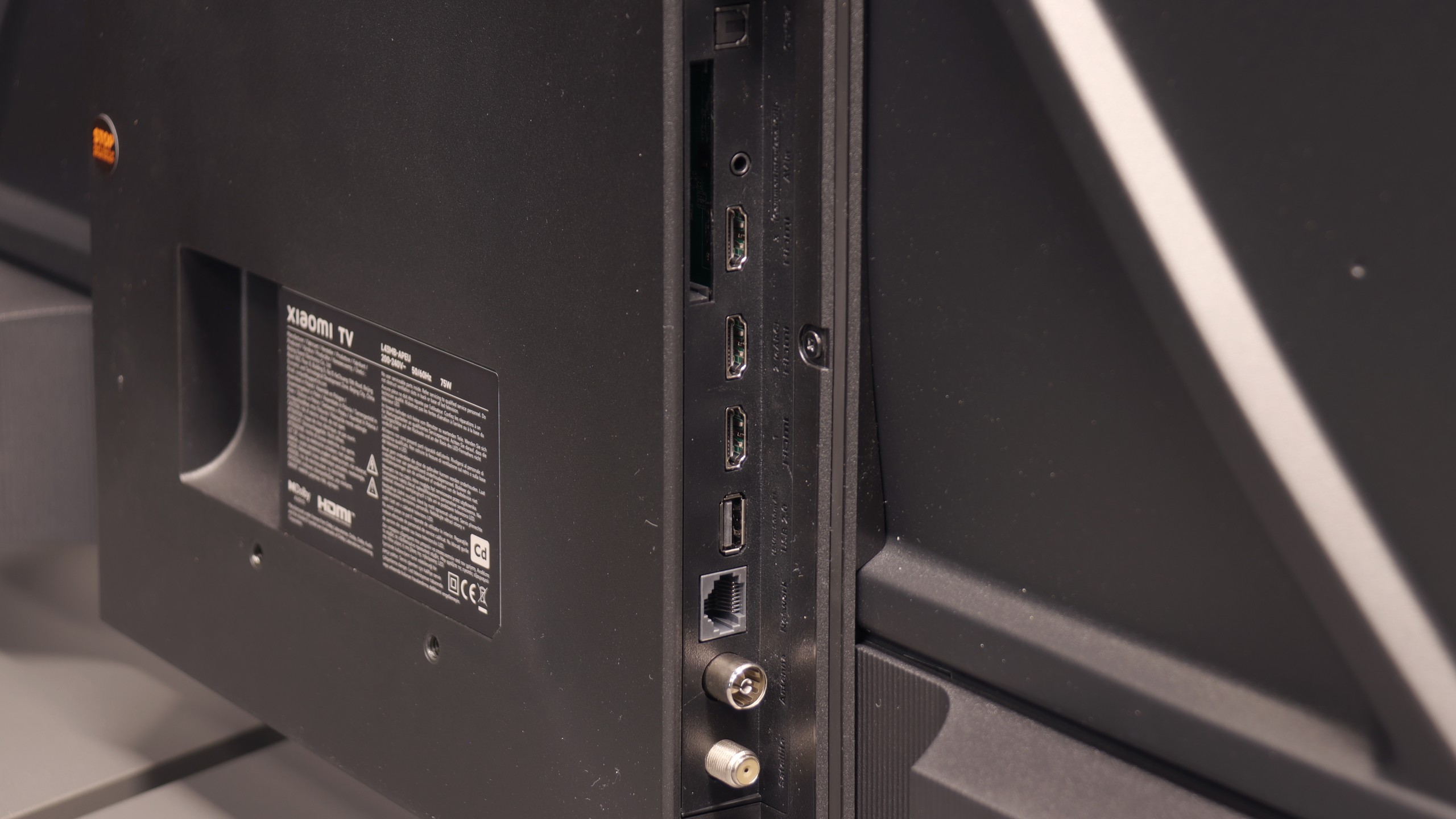
Samsung U8092F – like all this year's models from this brand – runs on the Tizen operating system. The system itself is really well developed: we have access to many applications (although not all), a well-developed smart home support, and various additions, including exclusive Samsung applications. Features such as AirPlay and Chromecast are also included, allowing us to easily connect our phone to the TV and stream multimedia.
Unfortunately, as this is Samsung's cheapest series in 2025, the manufacturer did not decide to include a solar remote. In the package, we find a classic infrared remote that visually resembles a newer version, but unfortunately lacks voice functions. When it comes to typical "TV" features – it misses recording functionality and the PiP (picture-in-picture) mode. On the positive side, though, the HDMI eARC works well, allowing for easy control of the included remote with devices like a decoder or soundbar – and it really works seamlessly.
SmartTV- Google TV
The biggest plus of the Xiaomi A Pro 2026 is the Google TV system. It gives the television a second life – you can run almost any app on it, from Netflix and YouTube to music services and even lesser-known programs from the Google Play store. We are not limited to what the manufacturer has pre-installed, as is often the case with other budget televisions. On top of that, we have AirPlay, voice search via Google Assistant, and even integration with Gemini. We did experience some small hiccups – for instance, screen mirroring from a laptop didn’t always work – but despite these shortcomings, Google TV is a huge advantage of this model.
Classic TV functions
The Xiaomi A Pro 2026 can be described as a "senior-friendly" television. The large remote with a numeric keypad and a considerable number of physical buttons makes it intuitive to operate. Support for teletext and a clear EPG interface make it easy to use classic television functions. We won’t find many advanced features like USB recording or PiP functionality, but the presence of an analogue headphone jack output can be surprisingly practical for some users. It gives the impression that this is a set of features tailored to the needs of the most traditional viewers.
System stability
However, not everything works as it should. During testing, we encountered annoying system lags, issues with Miracast, and problems when switching audio sources. There were times when a reset of the television was necessary by unplugging it from the power. This only shows that while Google TV offers enormous possibilities, the stability can still be very problematic in such a budget-friendly model.
Playing files from USB
9.3/10
6.8/10
Supported photo formats:
Maximum photo resolution:

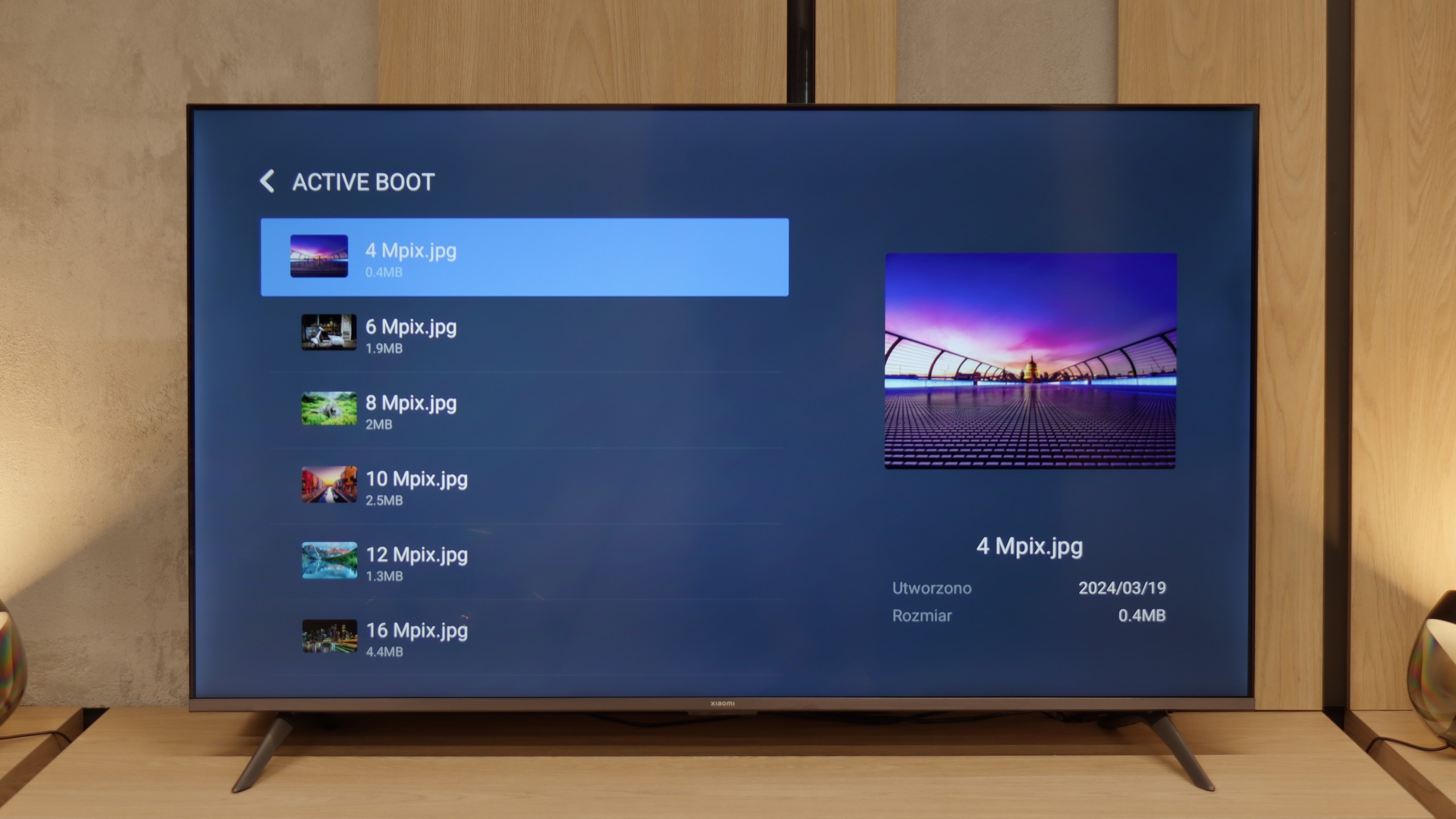
Samsung U8092F handles playback of files quite smoothly – the television supports most popular audio and video formats. Of course, it doesn’t support Dolby Vision, but you simply won’t find that in any Samsung model.
There are some reservations regarding the support for external text files – the ones that users would like to add as subtitles to a film. During our tests, the television only played TXT files, and other extensions like SRT or SUB unfortunately did not work. This may not be an issue for everyone, but it’s worth knowing. Perhaps this is a problem to be improved in the future with a software update for the television.
The built-in media player in the Xiaomi A Pro 2026 is quite a conundrum. On one hand, it plays most popular audio and video formats without major issues. On the other hand, it can struggle with basic things like Polish characters. Files with letters such as ą, ł, ć, or ś in the name often refuse to open or display incorrectly. It looks strange, because we supposedly have codec support, yet the TV simply gets lost on straightforward matters related to the alphabet. Fortunately, this isn’t a huge problem, as thanks to Google TV we can simply install another player, like VLC. At that point, the issue with Polish characters totally disappears and media usage becomes seamless.
Apps
8.7/10
9.6/10














































Sound
5.7/10
5/10
- Maximum volume-81dB
- Dolby Digital Plus 7.1
- Dolby True HD 7.1
- Dolby Atmos in Dolby Digital Plus (JOC)
- Dolby Atmos in Dolby True HD
- DTS:X in DTS-HD MA
- DTS-HD Master Audio
U8092F doesn't pretend to have a home theatre on board. We get the standard set of 2 x 10 W, which sounds fine but lacks excitement, albeit with a bit of bass. For everyday viewing, this audio setup is more than adequate. We were pleasantly surprised that it managed to play a movie with the built-in Dolby Atmos (JOC) codec – though of course, we're not talking about true surround sound here.
Last year, the Xiaomi A Pro 2025 surprised us with its pretty decent sound for a super budget segment television. Unfortunately, this year's edition – the A Pro 2026, has completely let us down. The sound feels like it's coming from underwater: flat, lacking any bass or depth. The only positive is the wide support for audio formats like Dolby Atmos and DTS:X, but in practice, it doesn't really change much. If you're considering this television, you'll need to factor in a soundbar straight away, as the audio experience without it will be quite disappointing.
Acoustic Measurements
No acoustic data
81dBC (Max)
75dBC


